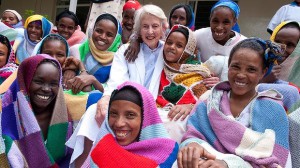 This afternoon, Australian time, Catherine Hamlin will wake up in a simple mud brick hut on a river in Addis Ababa. She will make her bed, eat a basic breakfast, walk up fifty stairs to a hospital and then operate on some of the world’s most disadvantaged women.
This afternoon, Australian time, Catherine Hamlin will wake up in a simple mud brick hut on a river in Addis Ababa. She will make her bed, eat a basic breakfast, walk up fifty stairs to a hospital and then operate on some of the world’s most disadvantaged women.
It’s just her Thursday routine, yet it’s nothing short of remarkable when you consider Dr Hamlin turns 90 tomorrow and has served Ethiopia’s women as long as their country’s average citizen actually manages to survive on this often cruel, always unfair earth.
While Catherine Hamlin will accept a call from the Governor General Quentin Bryce on Friday, she doesn’t want presents – just funds to continue her work to restore the health and dignity to women destroyed by something we take for granted: Safe birth.
In Australia, pregnant mothers focus on making their baby’s birth ‘beautiful’ and ‘powerful’ – we think about bath oils, ambience, music and massages. And while we worry about the pain, we know we will have professional assistance. In Ethiopia, most women hope their baby doesn’t die, doesn’t kill them or doesn’t damage them.
In Australia, if labor is obstructed, there’s a quick chat and a caesarian. In Ethiopia, a woman may have to walk for days for help only to die at a hospital gate. With only 200 obstetricians serving a nation of 91 million, childbirth is dangerous. Nine thousand women die every year and the same amount survive only to be badly damaged.
For these women a long obstructed labor breaks the lining between the vagina and the bladder or bowel. This fistula makes the women incontinent and in a land with little running water or sanitation, they smell and are then rejected, hidden, shamed or even seen as cursed.
When Catherine Hamlin and her late husband Reg arrived in Ethiopia in 1959 to train midwives, they’d never seen an obstetric fistula case. Yet they became their life’s work.
Despite fistulas caused by long labor being unheard of in Australia, Lucy Perry was so scared of giving birth she spent eight years trying to convince her husband to adopt. But when she did have a child she realized it didn’t hurt as much as she feared. (Lucy managed so well with her second labor she give birth in the bathroom at her own party while the oblivious guests danced to The Knack’s ‘My Sherona’.) Perry became so passionate about the ferocious strength and vulnerability women have in childbirth she became a doula or birth assistant.
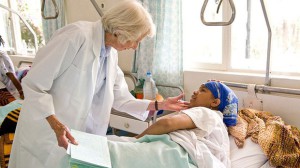 But after visiting Dr Hamlin’s hospitals in Ethiopia, Lucy began to see our lavender baths and pre-birth wax jobs as rather ludicrous. She watched African women living the grind of a subsistence lifestyle, suffering loss, pain and rejection and yet still show astounding grace, humility and bravery.
But after visiting Dr Hamlin’s hospitals in Ethiopia, Lucy began to see our lavender baths and pre-birth wax jobs as rather ludicrous. She watched African women living the grind of a subsistence lifestyle, suffering loss, pain and rejection and yet still show astounding grace, humility and bravery.
Upon returning home, Lucy assisted at a birth where the couple seethed about waiting for an extra pillow. “I thought: you’ve got a pillow and the midwife has washed her hands! What more do you need? Sure, context is everything but I realized I couldn’t do this job anymore. It was broken for me. You can’t un-see what you’ve seen. When you’ve seen fistula injuries with own eyeballs then meet people who want labiaplasty to look like a doll it’s all too much’.
Lucy is now the CEO of Hamlin Fistula Ethiopia and she and Catherine make a formidable and fabulously odd couple. One is a 90-year-old silver haired, conservative Christian. The other is a 40-year-old with a Mohawk. One would rather be operating quietly, rarely talking about what she does, the other loves raving to spread the word.
When Dr Hamlin’s former board tried to make the organisation a Christian Charity last year it led to an internal stoush and split that nearly broke Catherine Hamlin’s heart and badly affected her health. Perry helped her rebuild, refocus and rebrand. They are a shining example of what two privileged white women can do to help the most impoverished and powerless of their sisters.
There are now six obstetric fistula hospitals in Ethiopia run by local staff. Perry says, “We don’t treat the hole in the bladder we treat the whole person. Patients are given kindness, acceptance, surgery, a new dress, some literacy and numeracy, a plan for business and then sent them off on a new trajectory for life.”
There are also search and rescue vehicles that travel into the country and find women hidden away in shame. Other women walk for miles – some even from Sudan, Somalia and Eritrea with dead babies inside them for help from Hamlin’s staff. One walked 450 kilometers for treatment. None are turned away. Former patients are told to begin walking to the hospital when a new baby begins to walk inside them. They are then fed, cared for and given caesarians to prevent re-injury.
Dr Hamlin’s organisation has also set up a University for midwives. After earning their degree they are set up back to their region to help women in childbirth and family planning. “Eleven have graduated and since then we’ve not had one maternal death in those regions,” says Lucy. “I still give myself goose bumps telling you that.”
Australia is currently shifting its aid to focus on ‘strategic interests’. Impoverished Ethiopian women do not fit that category, so the Hamlin Fistula Ethiopia (Australia) now works to raise funds through donations. Its vision is to eradicate fistulas so the hospitals will be for safe, clean births. Lucy Perry says Catherine Hamlin used to hope that would happen in her lifetime but “recently she said to me it won’t happen in mine, I hope it will happen in yours.”
It’s an enormous task. But you’ve got to admire the dedication of a woman who has devoted her life to try.
Happy Birthday Catherine Hamlin, you are one of Australia’s most remarkable women.
For more see Hamlin.org.au.
By Sarah Macdonald









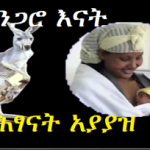
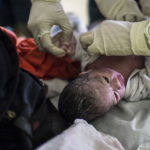


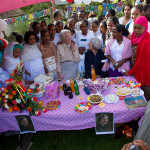














Join Conversations